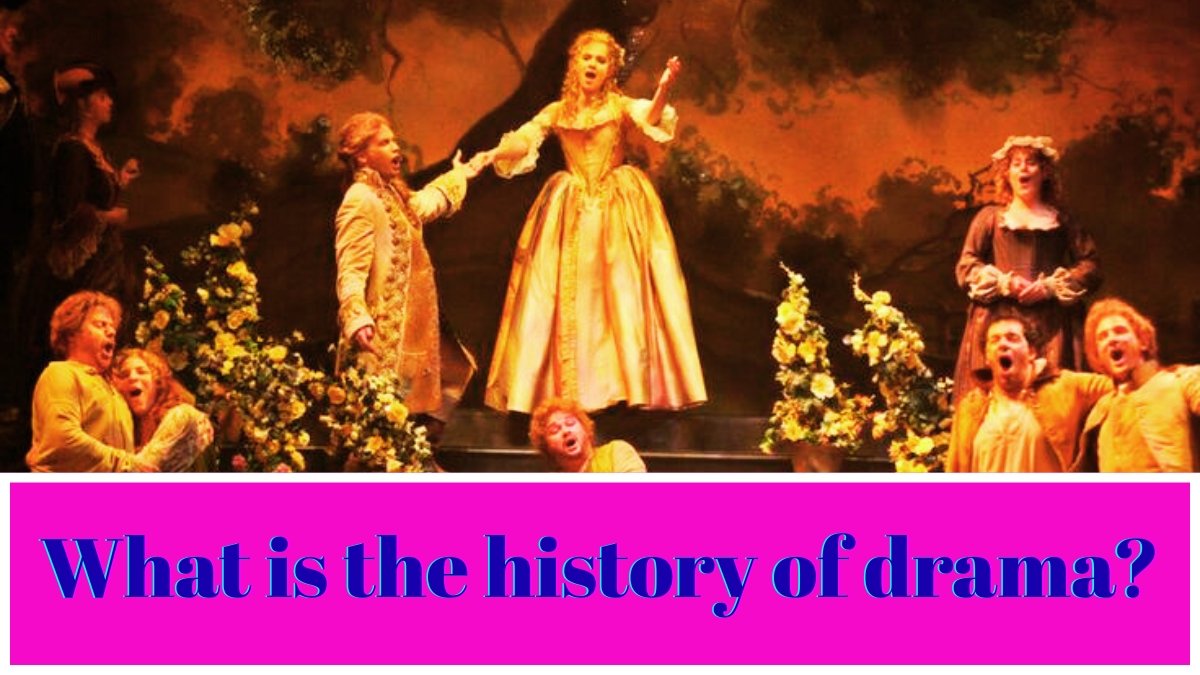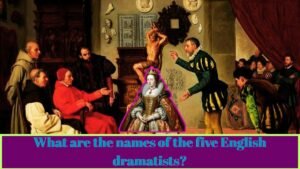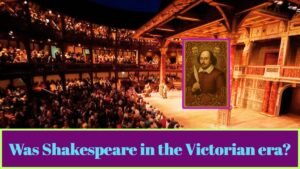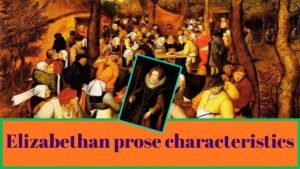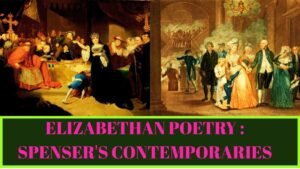What is the history of drama?
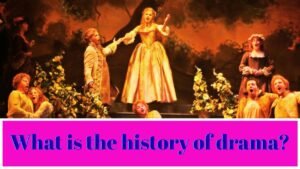
Religious origin of the drama in the middle ages-Miracle plays-Their collection in Cycles-Moralities: their growth in the 15th century side by side with the Miracles-Everyman and other moralities-Renaissance drama; decline of Miracles and bifurcation of Moralities into secular and religious The Four Elements-Bale’s King John-The Interlude: Heywood and The Four Ps-Classical influence on the drama-Ralph Roister Doister, the first comedy-Gammer Gurton’s Needle the first farce-Gorboduc the first tragedy-Transitional period of intense dramatic activities 1550-1590-The birth of the national theatre The University Wits: Lyly’s prose comedies on classical subjects-Peele’s plays on various subjects-Greene, Lodge and Nash-Kyd and his Spanish Tragedy-Marlowe’s plays.
What is the definition of a drama?
So far we have said nothing of the drama. Its consideration had to be postponed for good reasons. For one thing, the drama is a later growth; for another, the links in the chain of its development are not quite as clear as in the case of poetry and prose. Its period-wise treatment, therefore, would give a disjointed, if not confused, picture. In order that the student may have a conti-nuous and coherent view of its origin and development, it has been considered advisable to make at this stage a rapid survey of the whole field of the drama from its earliest beginnings to the point where Shakespeare took it up.
Medieval Drama (12th-15th centuries)
The drama arose in England, as in other Catholic countries of Europe, in the attempts of the clergy to teach the masses the tenets of the Christian faith by dramatising the services of the church at Christmas and Easter. The plays were in Latin, the language was of the liturgy, and the actors were clergy. Such scriptural plays in Latin are known to have been performed as early as the twelfth century. They were first given in the church, later in the church-yard. They became very popular after the institution by the Pope of the festival of Corpus Christi early in the fourteenth century. The sets of plays which were given separately at Christmas and Easter were now combined into one cycle performed on the occa-sion. Their language now was English and the plays had an ad-mixture of comic element to make them more entertaining. As the churchyards could not hold the growing crowds, the performance of the plays was taken over by the towns. As the Corpus Christi festival was celebrated with a ‘pageant’ or procession, these plays were given on moving platforms which themselves came to be called ‘pageants’. They were not unlike the procession of moving plat-forms during the Ram Leela celebrations in India. The whole of the Scriptural story from the birth of Christ to his crucifixion and ascension was enacted in a cycle of plays called Miracles or Myste-ries. A distinction is sometimes made between ‘mysteries’ and ‘miracles’, the former denoting plays dealing with the life of Christ and the latter those dealing with the lives of the saints. This dis-tinction is true of France, not of England, where all plays were indiscriminately called Miracles.
The complete cycle of plays was spread over several days. Each guild or trade union of the town made itself responsible for the production of the play appropriate to it. For example, the play of the flood would be assigned to the guild of shipwrights, the adora-tion of the Magi, who presented the infant Christ with gold and jewellery, to the guild of goldsmiths, and so on.
The Miracles were well established by the fifteenth century and were very popular. Four cycles of these plays besides minor ones have been preserved. Named after their town they are: Cycles of York, Chester, Coventry and Wakefield (also called Townley plays after the family that owned thein). The York collection, the big-gest, consists of 48 plays.
These plays by unknown authors are written in stanzas of dog-grel verse and are simple though crude in style. Here and there, however, one comes upon scenes both of extreme pathos and of homour. A good example of the pathetic is the play of Abraham and Isaac, in which Abraham offers to sacrifice his son Isaac. But the anonymous writers show the greatest originality in the interpola-ted scenes of humour. Two scenes in the Wakefield collection are the most amusing. The one shows the lively quarrel between Noah and his shrewish wife who has to be beaten into submission before the Ark can proceed. The other, in the Nativity play, is a farcical comedy. Mak steals a sheep belonging to the shepherds who are going to visit the baby Christ. A search follows and the sheep is discovered in a cradle in Mak’s house. Mak’s wife pretends to have been just delivered of a child. One of the shepherds there-upon proceeds to offer a present to the baby who is discovered to be no other than the stolen sheep.
Moralities
The second stage in the development of the drama was reached in moral plays or Moralities. These grew up side by side with the miracles in the fifteenth century. The earliest extant morality, the Castle of Perseverance, dates back to early fifteenth century. The Morality was a sort of allegory of human life showing man strug-gling between Good and Evil. The characters were abstractions–personifications of virtues and vices. The early moralities like Man-kind, Hickscorner and others are awfully dull. The only exception is Everyman which is so good that it has been revived on the modern stage in both England and America. Everyman is summon-ed to God by Death. He seeks company and visits one after another, Fellowship (friends), Kindred (relations), and Goods (earthly possessions), but in vain. He at last remembers Good Deeds who willingly accompanies him. The moral is obvious.
Renaissance Drama
With the advent of the Renaissance and the triumph of Protes-tantism the Miracles declined. The moralities, however, survived, and were used to reflect either humanism or the spirit of the refor-med religion. In other words the moralities became either secular or religious. Skelton’s Magnificence (1516), the earliest example of secu-lar morality, was aimed at the extravagance of Henry VIII. Others to follow, of the same class, such as The Four Elements and Wit and Science stressed the importance of knowledge and denounced igno rance. The Reformers used morality to propagate their own views in such plays as Lyndsay’s Satire of the Three Estates (1540) in Scotland, and Bishop Bale’s King John (1547) in England. The three estates, satirised by Lyndsay are the Clergy, the Nobility and the Citizens, the chief target being the Romish priests. Bale mixes history with his morality and in doing so falsifies history. John, the worst King of England, is shown as a great King who is malig-ned by the church because he had repudiated the Pope. This morality anticipates Shakespeare’s King John.
The secular morality took a long step forward when it developed into a kind of play called the Interlude, which is nothing but rudimentary comedy.
The most prolific writer of these interludes was John Heywood, a musician in the court of Henry VIII. His aim was simply to amuse and not to moralise. His most famous interlude is The Four Ps, in which a Palmer, a Pardoner, a Potycary (apothecary or chemist) and a Pedlar dispute as to which of them could tell the biggest lie. The Palmer, naturally a much travelled man, says during all his travels he never once met a woman out of temper! The others agree that this is the prize-winning lie.
Heywood discarded the abstractions of the moralities and intro-duced in their place human characters taken from contemporary life. Further, by avoiding moralising and concentrating on pure amusement his new and very merry interludes’ prepared the way for comedy.
CLASSICAL INFLUENCE ON THE DRAMA-THE FIRST COMEDY AND THE FIRST TRAGEDY
Though humanism had used the morality for its own purposes early in the sixteenth century, it was not till 1550 that the classics made their full impact upon English drama. The first English comedy was Ralph Roister Doister written by Nicholas Udall, headmaster of Eton. It was first acted about 1553. It was modelled on the Latin comedy of Plautus and Terence and divided into five acts. It was not, however, pure imitation. Some of the characters are borrowed from the classics classics and others are taken straight from English life. Ralph, a foolish braggart, and Mathew Merrygreek, the mis-chievously funny servant, are stock characters of Latin comedy. Dame Constance, the ‘heroine’, (betrothed to Goodluck) and her two maids, are contemporary English types. The fun and laughter arise from Merrygreek’s changing the punctuation of Ralph’s love letter. Ralph is beaten and driven away by Constance and her maids. Goodluck estranged from his fiancee by false reports is reconciled to her. The play is written in rhymed verse.
Another and even better comedy or rather farce, Gammer Gurton’s Needle, was produced a little later at Cambridge. There is nothing classical about it except its regular construction and division into acts and scenes. It is a farce of rustic English life. Gammer Gurton loses her needle which is supposed to have been stolen by a neighbour. The search that follows leads to noisy quarrels and the whole village is in an uproar until the dame’s man, Hodge, screams and the needle is found sticking in his pants.
These two, historically important as they are, as the precursors of later English comedy, did not contribute much to the progress of the drama beyond separating the comic element from the serious, which in fact had already been done in Heywood’s interludes. Real advance was made in the first tragedy, Gorboduc or Ferrex and Porrex, acted in 1561 and written by two lawyers Sackville and Norton. The writers were inspired by the Roman tragedian Seneca, more a closet than a stage dramatist. His tragedies are rhetorical and fit for declamation rather than acting on the stage. There is a Chorus who explains the theme of the play. There is very little action on the stage. All action takes place off the stage and is simply reported. The story is of unrelieved gloom, full or violent and monstrous crime, bloodshed and horror. King Gorboduc abdicates in favour of his sons Ferrex and Porrex who immediately start a war. Ferrex, the elder is slain by Porrex who in his turn is killed by the mother in vengeance. The subjects rise in rebellion and kill the king and queen. This leads to civil war, anarchy, usur-pation. The usurper is also killed, leaving the throne vacant. The author’s aim was to depict the consequences of a disputed succes-sion and thus indirectly to persuade Queen Elizabeth to marry and leave an heir. The The important thing to note about Gorboduc, how-ever, is that it is the first irst play in English to be written in blank verse under the influence of the classics. The oratorical manner of the Senecan tragedy did not suit the national genius and was rejected in favour of spectacular action, but the blank verse was adopted as the most suitable metre for the drama.
This advance, however, was not pursued immediately. It took about 25 years before effective use of blank verse was made in Kyd’s Spanish Tragedy and Marlowe’s Tamburlaine (1586). But in speaking of Kyd and Marlowe we are anticipating. We have still to see what the state of drama was during the years 1550-1590. It must not be supposed that the three plays referred to above and conventionally called the first comedy, the first farce, and the first tragedy were the only plays produced dur-ing these years. There were others-hundreds of them-which tes-tify to the intense dramatic activity of this period. It was a time of experiment and the plays are impossible of classification as comedy, tragedy or historical play. They are a medley or mixture of two or more kinds-morality, interlude, history, romance, clas-sical, tragedy, farce and what not-aiming at variety rather than unity. Variety has always been characteristic of English drama. Moreover, other influences besides the classical were also at work. These were imitations or adaptations of Spanish and Italian plays. These plays were written in all all sorts of metres, mostly doggerel. Many of these plays have disappeared and such of them as have been preserved are of unknown authorship and uncertain date, making it impossible to trace the lines of development. To add to the confusion plays were often written in collaboration and old plays were being constantly refurbished to satisfy the craze for novelty. These transitional plays, the plays, in Saintsbury’s phrase, of ‘this twilight period’ of English drama have no poetic or dram tic merit and are therefore of little practical importance except to the specialist. Their historical importance, however, is clear. They provided a field of exercise for the national dramatic genius, which made the great outburst of Elizabethan drama in Shakespeare and others possible.
It was during this period of confusion, moreover, that the national theatre was born. The Reformed Church was hostile to the drama because of its early association with the Romish church and the ultra-Protestants or Puritans were much more so. Professional players were regarded as rogues and vagabonds. In order to escape being so branded, they formed companies and attached themselves to this or that nobleman, e g. the Earl of Leicester’s ‘servants’ or the Lord Chamberlain’s ‘servants’. Though opposed by the Puri-tans, the drama was very popular with the royalty, the nobility as well as the common people. Since the Puritans dominated the Corporation of London, no performances were permitted within the municipal limits. They shifted therefore beyond the City and the first theatre called simply the Theatre was built in 1570. Others followed en both banks of the Thames.
The University Wits
Towards the close of this transitional period appear a group of highly gifted writers who at one bound, as it were, pulled the drama out of the sphere of childish experiment into that of art. The members of this group were all or almost all university-men and from a playful phrase applied to them at the time are known as ‘University Wits. They are John Lyly, George Peele, Robert Greene, Thomas Lodge, Thomas Nash, Kyd and Christopher Mar-lowe. They were the real founders of the great Elizabethan drama and the immediate predecessors as well as contemporaries of Shakes-peare, who not only took many a hint from them but, as tradition has it, collaborated with some of them, notably Kyd and Marlowe.
Lyly who made his name with his Euphues belongs more to the history of prose than to that of drama. His plays in euphuistic prose, written for the entertainment of the court, are masque-like comedies on classical subjects-Campaspe, Endymion, Love’s Meta-morphoses, etc. The dramatic element in them is slight, but they are highly artistic with the charm of fancy, wit and satire far remo-ved from the crudities of the earlier comedies. They prepared the way for Romantic comedy of Shakespeare.
Peele’s plays show a great variety of subjects: classical, romantic, biblical, historical, The Arraignment of Paris is classical, David & Bethsabe (Bathsheba) biblical, Edward I historical and The old Wive’s Tale romantic. He is no more dramatic than Lyly, but he is as charming in his verse as Lyly is in his prose. His blank verse, sweet and supple, is a distinct advance on that of Gorboduc.
Greene, Lodge and Nash form a more or less distinct group or sub-group of playwrights who wrote for the popular stage. Of these Greene alone is remarkable as a dramatist. In Friar Bacon and Friar Bungay and James IV he sketched charming pictures of pure, self-sacrificing women that anticipate the romantic heroines of Shakespeare-Rosalind, Viola, Imogen. Lodge and Nash were mediocre as dramatists, though they excelled in other fields. Both of them wrote poems, pamphlets and prose fiction. The student remembers Lodge as the writer of the novel Rosalynd which Shake-speare refashioned in As You Like It. Nash distinguished himself as a satirist.
Kyd and Marlowe. While all these made real contributions to the development of the drama, they did not supply thrilling action demanded by the public. This was supplied by Kyd and Marlowe. Whether Kyd’s Spanish Tragedy or Marlowe’s Tamburlaine came first it is difficult to say;what is certain is that both made a hit about the same time 1586 or 1587. The Spanish Tragedy which outdoes Seneca as a ‘horror’ play was a sensation, and its popularity was not only immediate but lasted till the end of the century or even beyond. The literature of the time is full of references to it. Ben Jonson refers to it in his Everyman in his Humour.
The play is a sensational melodrama whose theme is revenge. It opens with the revelation made by the ghost of Don Andrea that he has been foully murdered by Balthazar and calling for revenge. This story forms the framework of the action that follows.
Horatio, son of Hieronimo, Marshal of Spain, comes to tell the Spanish princess Bellimperia how her fiance Andrea has been treacherously murdered by Prince Balthazar. They fall instantly in love and make an appointment to meet at night in Hiero-nimo’s garden. Their meeting is interrupted by the appearance of assassins who kill Horatio. Hieronimo and the princess vow vengeance on the murderers. In order to achieve his design the distracted father feigns madness and arranges the staging of a play at the wedding of Bellimperia who is forced to marry Balthazar, her lover’s murderer. The play instead of being a mere play is played in right earnest and everyone of the wedding party is killed or kills himself. Other horrors follow including Heironimo’s killing of the father of one of the murderers and also himself.
This piling up of horror upon horror was the wine that intoxi-cated the audience. They cared nothing for the regular construc-tion or the unities of classical drama. What they wanted was thrills and Kyd supplied them with a vengeance. The sensational plot with its ghost, intrigue, violence and bloodshed together with declamatory speeches established in general the content, as its powerful blank verse established the medium, of the romantic drama. Shakespeare indeed moderated the sensationalism of Kyd, but it remains true that it was the sensational plot of his tragedies that attracted contemporary audiences. Shakespeare took more than one hint from the Spanish Tragedy in his Hamlet. It is even possible, as most critics suggest, that he may have read an older Hamlet, now lost, written probably by Kyd.
Marlowe (1564-93). The other purveyor of thrills on the stage, Marlowe, was the youngest of the University Wits and also the greatest of them all. Marlowe, son of a shoemaker of Canterbury was born in 1564. He was educated at the King’s School Can-teramry and at Cambridge. He was accused of atheism and lived the loose life of a Bohemian. He died as the result of a drunken brawl at the age of twenty nine. His major works are the four plays-Tamburlaine, Dr. Faustus, The Jew of Malta and Edward II. The minor works include two plays-The Massacre at Paris, Dido, Queen of Carthage and the non-dramatic poem Hero and Leauder. The heroes of the first three plays are each consumed by a burning passion which leads to their doom. In Tamburelaine this passion is thirst for power. Urged by the lust of conquest Tam-burlaine-Taimur Lung or Taimur, the lame the fourteenth century Tartar, ravages the whole of Asia. Students of Indian history will remember him as the man who massacred one lakh
Massare of St. Bartholomew, 1572; a general messacre of French Protestants throughout France, on the festival of St Bartholomew
prisoners in Delhi. Utterly contemptuous of human life and morality, this most blood-thirsty butcher of history until Hitler, has his chariot drawn by captive Kings lashed forward like horses. Marlowe shows him as a superman or demigod exulting over his victims and hurling defiance at God in declamatory blank verse speeches of a power never heard before.
Inspite of its extravagances, the play pleased. The audiences treated to such spectacles and such speeches were dazzled, as no doubt Marlowe must have been by his success. His Taimur was only a projection of himself imbued with a like passion for power, glory and beauty. One forgets the rant and bombast of the barbarian when in their midst he utters this paean to Beauty:
If all the pens that ever poets held, Had fed the feeling of their masters thoughts, And every sweetness that inspired their hearts, Their minds, and muses on admired themes: If all the heavenly quintessence they still From their immortal flowers of poesy, Wherein as in a mirror we perceive The highest reaches of a human wit-If these had made one poem’s period All all combined in beauty’s worthiness, Yet should there hover in their restless heads, One thought, one grace, one wonder at the least, Which into words no virtue can digest:
Marlowe is his own hero and in this passage expresses the Renais-sance artist’s aspiration for the infinite.
Dr. Faustus is the story of a man coming to grief by his unbrid-led thirst for knowledge and power. He sells his soul to the Devil in exchange for supreme knowledge and the power that knowledge gives, for 24 years. Dr. Faustus echoes Marlowe’s ambition for unlimited knowledge and power when he says: own
All things that move between the quiet poles shall be at my command’
When to satisfy his desire for matchless beauty he calls up Helen of Troy, he is dazzled and utters the loveliest lines of the play, lines that have not been equalled, much less surpassed, even by Shakespeare:
‘Was this the face that launch’d a thousand ships, And burnt the topless towers of Ilium? Sweet Helen, make me immortal with a kiss.
At last the twenty four years are over and the time to pay the price has come. The clock strikes twelve and the devils drag him to hell. His anguished cry of horror is drowned by thunder and lightning.
The play is inferior to Tamburlaine, but being free from its ex-cesses and shorter is more popular today. It has some powerful passages of poetry, notably the Helen passage above referred to and that in the last scene of anguish before the doctor’s approaching damnation. The similarity between Dr Faustus and Marlowe gives another interest to the play. The pathetic epilogue spoken by the Chorus on the terrible fate of Dr Faustus acquires additional piquancy when we remember the premature and sad end of the dramatist:
Cut is the branch that might have grown full straight, And burned is Apollo’s laurel bough That sometime grew within this learned man.
Marlowe nad no sense of humour and the clowning scenes in the play are so bad that one wonders if they were written by him.
In The Jew of Malta the passion is greed of riches as well as hatred of enemies. The Jew, Barabas, is ruined by Christians, and in revenge he contrives incredible cruelties until he falls into a cauldron of boiling water which he had prepared to destroy his enemies. This is a real ‘horror’, play a fit match for Tamburlaine.
In Edward II Marlowe descends from these superhuman heights to reality and history. It is the first great historical play and pointed the way to Richard II, King John and other historical plays of Shakespeare. It is a real attempt at the interpretation of history, studies character, has dramatic qualities. Marlowe’s usual lyrical eloquence shows itself in the speeches of the King and particularly in the great speech of Mortimer who ‘as a traveller goes to discover countries yet unknown. This lyricism. however, is restrained and is nothing like the outbursts in Tamburlaine and the Jew of Malta And the murder of the King in prison is one of the most pathetic scenes in Elizabethan drama.
In any assessment of Marlowe, the fact of his early death must never be forgotten. Judging from the quality of the work he accomplished one can have little hesitation in saying that had he been granted the normal span of life he would have been a serious rival of Shakespeare. Even as it is. Shakespeare was indebted to him in more ways than one. The influence of Marlowe is evident in Richard II, Richard III and even in King John. As a dramatist, however, and only as a dramatist, he is far behind Shakespeare. He had neither the universality of Shakespeare nor his penetrating knowledge of human nature. He could not draw women and he had no sense of humour. His heroes are no men but giants or monsters and their actions and speeches extravagant, even absurd. But all these deficiencies and faults are carried off by his vehemence and the splendour of his poetry. He may be inferior to Shakespeare as a dramatist, but as a poet and technician of blank verse, his ‘mighty line’, he is second to none. Shakespeare did not forget his master and paid the ‘dead Shepherd’ (poet) a handsome tribute when he made Phebe in As You Like It quote the line from Hero and Leander:
Dead shepherd, now I find thy saw of might, Whoever loved. that loved not at first sight?
